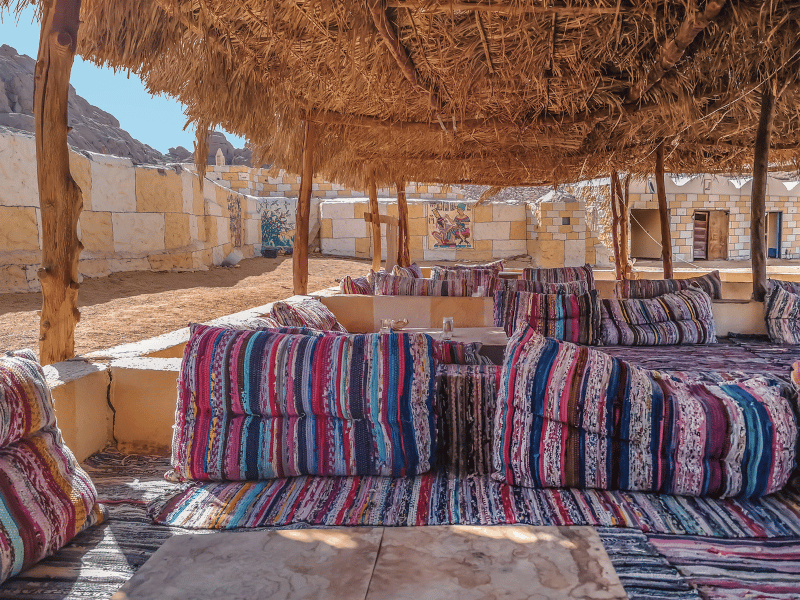Guardians of Desert Traditions
Nestled among rugged mountains along Egypt’s Red Sea coast exists a close-knit community preserving a way of life unchanged for centuries. Referred to simply as “Bedouin Village”, though permanently settled, its inhabitants remain proud nomads at heart as they uphold treasured ancestral customs passed through generations since time immemorial.
- Place: Bedouin Village
- Country: Egypt
- Governorate: New Valley Governorate, Egypt
- Age: Unknown
- Population: Unknown
- Discovered by: Bedouin tribes themselves (originating inhabitants)
- Famous for: Depicting traditional nomadic Bedouin lifestyle
- Nearby locations: Saint Catherine’s Monastery (80km northwest), Wadi Allaqi Protected Area (60km south)
Woven Homesteads Blending with Surrounds
Constructed from local natural materials, the village ingeniously integrates into the desert environs. Mats of small branches and twigs are lashed over timber frames, then sealed with packed earth.
Within flexible woven walls stand furnishing, art and household wares all contributing to a mobile lifestyle evoking romanticized Bedouin imagery. Their harmony with nature ensures minimal environmental impact for sustained future inhabitability.
Within flexible woven walls stand furnishing, art and household wares all contributing to a mobile lifestyle evoking romanticized Bedouin imagery. Their harmony with nature ensures minimal environmental impact for sustained future inhabitability.







Threads of Connection Spanning Aeons
Observing Bedouin women at work, one witnesses traditions millennia in the making.
With calloused hands they card wool shorn from prized goat flocks, then spin and dye yarn before weaving intricate textiles.
Their artistic designs remain recognizable links connecting present communities across the remote deserts to their earliest pastoralist ancestors. Such handicrafts also serve to preserve cultural identity amid modernity’s rapid changes.
With calloused hands they card wool shorn from prized goat flocks, then spin and dye yarn before weaving intricate textiles.
Their artistic designs remain recognizable links connecting present communities across the remote deserts to their earliest pastoralist ancestors. Such handicrafts also serve to preserve cultural identity amid modernity’s rapid changes.
Nurturing Life in Harsh Terrain
Beyond artistic heritage, Bedouin have innovated resourceful strategies for adapted desert survival.
Far-reaching pastoral networks maintain sustainable herds across shifting grazing lands. Traditional foods like “khoubiz” – sun-dried bread – are staples during migrations.
Even now, older generations pass on botanical knowledge for medicinal and utility wild plants entwined within the fabric of their resilient society. Through such lessons of self-sufficiency, they set enviable examples for modern living aligning with nature.
Far-reaching pastoral networks maintain sustainable herds across shifting grazing lands. Traditional foods like “khoubiz” – sun-dried bread – are staples during migrations.
Even now, older generations pass on botanical knowledge for medicinal and utility wild plants entwined within the fabric of their resilient society. Through such lessons of self-sufficiency, they set enviable examples for modern living aligning with nature.
Safeguarding a Testament to Human Perseverance
A visit to Bedouin Village offers rare insights into an enduring nomadic lifestyle. With their hospitality and expertise, inhabitants bring to life histories akin to folklore.
Yet more significantly, they represent the very real people who have pioneered life in Earth’s harshest climes for millennia through fellowship, ingenuity and reverence of nature’s rhythms. Their cultural continuance inspires humanity to thoughtfully coexist within our fragile worlds, as Bedouin have exemplified since time out of memory.
Yet more significantly, they represent the very real people who have pioneered life in Earth’s harshest climes for millennia through fellowship, ingenuity and reverence of nature’s rhythms. Their cultural continuance inspires humanity to thoughtfully coexist within our fragile worlds, as Bedouin have exemplified since time out of memory.



